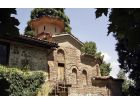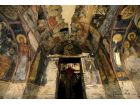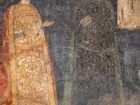UNESCO sites, Boyana Church
Boyana Church
The church of Boyana is situated in Boyana – a suburb of Sofia.
It consists of three parts built in three stages.
The first stage was in the end of the 10th century and in the beginning of the 11th century.
The second one was in the middle of the 13th century and the last one – in the middle of the 19th century.
The construction of the first cross-shaped part was connected with the Boyana fortress which exited at that time.
The temple was built of bricks and is a small almost cubic cross-shaped building.
During the 13th century the old temple was widened with the building of the two-storied second part at the west side of the church. It has a dome of a church-tomb type.
There are two niches on the down floor, where the church donors sebastocrator Kaloyan and his wife Desislava, who were ruling Sofia district during this period, should have been buried.
The second floor was approached through a door on the southern façade with several steps under it, which didn’t reach the terrain. Probably a step-ladder served as an extra connection and its removal turned the family chapel into a defensive facility.
The second part was built of stones and bricks, and its façade has ceramic decoration.
The third part of the church was built during the Bulgarian Revival with funds donated by local people and it serves as a narthex.
The importance of the church of Boyana as a cultural monument is mostly due to its superb frescoes.
Very little has survived from the frescoes of the first church.
When the second part was built, the two connected buildings were completely repainted.
The painter’s name is not known and he is simply called the Boyana master.
The pictures are realistic and vivid.
The face of Jesus Christ, traditional scenes from the Bible, figures of saints were painted in the second church.
There are life-size portraits of the sebastocrator’s and the royal couples.
The portraits of Kaloyan and his wife Desislava are the oldest ones in Bulgarian art which have been drawn from nature. They are wearing official clothing, the face of Kaloyan is sophisticated and noble and Desislava is thought to be the most beautiful female face from her time.
Kaloyan presents Saint Nikola, painted next to him, with a model of the church, which was devoted to the saint.
The chapel on the second floor is devoted to Saint Panteleymon.
King Constantine and his wife Irina are wearing crowns and brocaded clothing.
The King holds a sceptre in his hands.
The frescoes of Boyana from 1259 have a high artistic qualities and undisputable contribution to the European art culture. They also have historical and documentary value.
The Boyana Churchwas included in the World Cultural and Natural Heritage List at the World Cultural and Natural Heritage Committee session of 1979 in Luxor, Egypt







